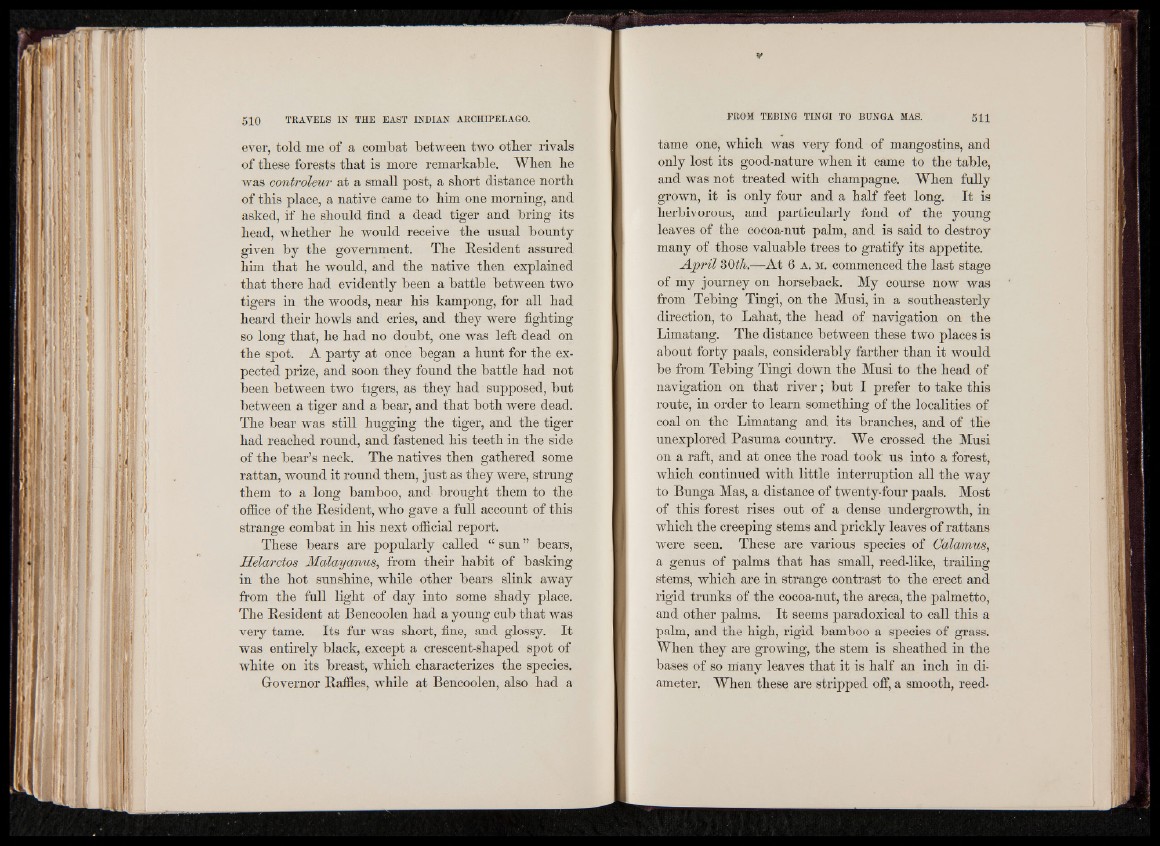
ever, told me of a combat between two other rivals
of these forests that is more remarkable. Wken be
was coniroleur at a small post, a sbort distance north
of this place, a native came to him one morning, and
asked, if he should find a dead tiger and bring its
head, whether he would receive the usual bounty-
given by the government. The Resident assured
him that he would, and the native then explained
that there had evidently been a battle between two
tigers in the woods, near his kampong, for all had
heard their howls and cries, and they were fighting
so long that, he had no doubt, one was left dead on
the spot. A party at once began a hunt for the expected
prize, and soon they found the battle had not
been between two tigers, as they had supposed, but
between a tiger and a bear, and that both were dead.
The bear was still hugging the tiger, and the tiger
had reached round, and fastened his teeth in the side
of the bear’s neck. The natives then gathered some
rattan, wound it round them, just as they were, strung
them to a long bamboo, and brought them to the
office of the Resident, who gave a full account of this
strange combat in his next official report.
These bears are popularly called “ sun ” bears,
Helarctos Malaya/nus, from their habit of basking
in the hot sunshine, while other bears slink away
from the full light of day into some shady place.
The Resident at Bencoolen had a young cub that was
very tame. Its fur was short, fine, and glossy. It
was entirely black, except a crescent-shaped spot of
white on its breast, which characterizes the species.
Governor Raffles, while at Bencoolen, also had a
tame one, which was very fond of mangostins, and
only lost its good-nature when it came to the table,
and was not treated with champagne. When fully
grown, it is only four and a half feet long. It is
herbivorous, and particularly fond of the young
leaves of the cocoa-nut palm, and is said to destroy
many of those valuable trees to gratify its appetite.
A p ril 30th.—At 6 a . m . commenced the last stage
of my journey on horseback. My course now was
from Tebing Tingi, on the Musi, in a southeasterly
direction, to Lahat, the head of navigation on the
Limatang. The distance between these two places is
about forty paals, considerably farther than it would
be from Tebing Tingi down the Musi to the head of
navigation on that river; but I prefer to take this
route, in order to learn something of the localities of
coal on the Limatang and its branches, and of the
unexplored Pasuma country. We crossed the Musi
on a raft, and at once the road took us into a forest,
which continued with little interruption all the way
to Bunga Mas, a distance of twenty-four paals. Most
of this forest rises out of a dense undergrowth, in
which the creeping stems and prickly leaves of rattans
were seen. These are various species of Calamus,
a genus of palms that has small, reed-like, trailing
stems, which are in strange contrast to the erect and
rigid trunks of the cocoa-nut, the areca, the palmetto,
and other palms. It seems paradoxical to call this a
palm, and the high, rigid bamboo a species of grass.
When they are growing, the stem is sheathed in the
bases of so many leaves that it is half an inch in diameter.
When these are stripped off, a smooth, reed